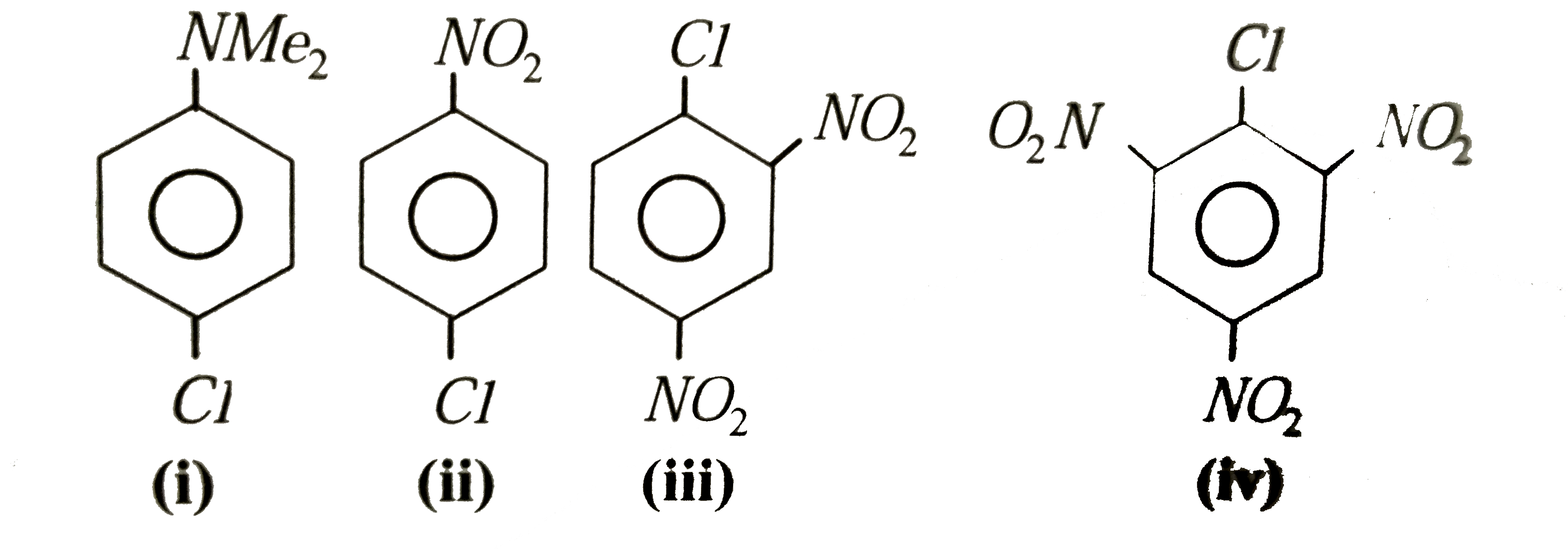Assertion: Electron withdrawing groups in aryl halides decrease the reactivity towards nucleophilic substitution.
Reason: 2,4-Dinitrochlorobenzene is less reactive than chlorobenzene.
If both Assertion and reason are true and the reason is the correct explanation of the assertion.
If both assertion and reason are true but reason is not the correct explanation of the assertion.
if assertion is true but reason is false.
if assertion is false but reason is true
The correct Answer is:D
To analyze the assertion and reason provided in the question, we will break it down step by step.
Step 1: Understanding the Assertion
The assertion states that "Electron withdrawing groups in aryl halides decrease the reactivity towards nucleophilic substitution."
- Explanation: In nucleophilic substitution reactions, the presence of electron-withdrawing groups (EWGs) such as nitro groups (-NO2) can stabilize the negative charge that develops during the reaction. However, they also make the carbon atom attached to the halogen (like chlorine) less electrophilic because they pull electron density away from the aromatic ring. This can lead to a decrease in reactivity towards nucleophilic substitution.
Step 2: Understanding the Reason
The reason states that "2,4-Dinitrochlorobenzene is less reactive than chlorobenzene."
- Explanation: 2,4-Dinitrochlorobenzene has two nitro groups that are strong electron-withdrawing groups. These groups significantly reduce the electron density on the aromatic ring, making the carbon atom bonded to chlorine less reactive towards nucleophiles compared to chlorobenzene, which has only one chlorine atom and no electron-withdrawing groups.
Step 3: Evaluating the Assertion and Reason
Now, we need to evaluate whether both the assertion and the reason are true or false.
- Assertion Evaluation: The assertion is true because electron-withdrawing groups do indeed decrease the reactivity of aryl halides towards nucleophilic substitution.
- Reason Evaluation: The reason is true as well because 2,4-Dinitrochlorobenzene is indeed less reactive than chlorobenzene due to the presence of the two electron-withdrawing nitro groups.
Step 4: Conclusion
Both the assertion and the reason are true, and the reason correctly explains the assertion.
Final Answer
Both the assertion and the reason are true, and the reason correctly explains the assertion.
---
The assertion states that "Electron withdrawing groups in aryl halides decrease the reactivity towards nucleophilic substitution."
The reason states that "2,4-Dinitrochlorobenzene is less reactive than chlorobenzene."
Now, we need to evaluate whether both the assertion and the reason are true or false.
- Reason Evaluation: The reason is true as well because 2,4-Dinitrochlorobenzene is indeed less reactive than chlorobenzene due to the presence of the two electron-withdrawing nitro groups.
Both the assertion and the reason are true, and the reason correctly explains the assertion.
Both the assertion and the reason are true, and the reason correctly explains the assertion.
Similar Questions
Knowledge Check
Aryl halides are less reactive towards nucleophilic substitution because
ALess stable carbonium ionBDue to largeC−CI bond energyCInductive effectDResonance stabilization and sp2-hybridisation of C attached to halide .The correct order of reactivity towards nucleophilic substitution reaction is
ACH3F>CH3Cl>CH3Br>CH3IBCH3I>CH3Br>CH3Cl>CH3FCCH3I>CH3Cl>CH3Br>CH3FDCH3I>CH3Br>CH3F>CH3ClAryl halide is less reactive than halide towards nucleophilic substitution because
ALess stable carbonium ionBDue to large C-Cl bond energyCInductive effectDResonance stabilization and sp2 hybridisation of C attached to halide
Nucleophilic substitution reaction of 2,4-dinitrochlorobenzene is faster than p- nitrochlorobenzene . Give reason
View SolutionWhich is least reactive towards nucleophilic substitution (SN2)
View SolutionWhich is least reactive towards nucleophilic substitution (SN2)
View SolutionAryl halides are less reactive towards nucleophilic substitution reaction as compared to alyl halides due to
View SolutionWhich of the following is least reactive towards nucleophilic substitution?
View Solution

